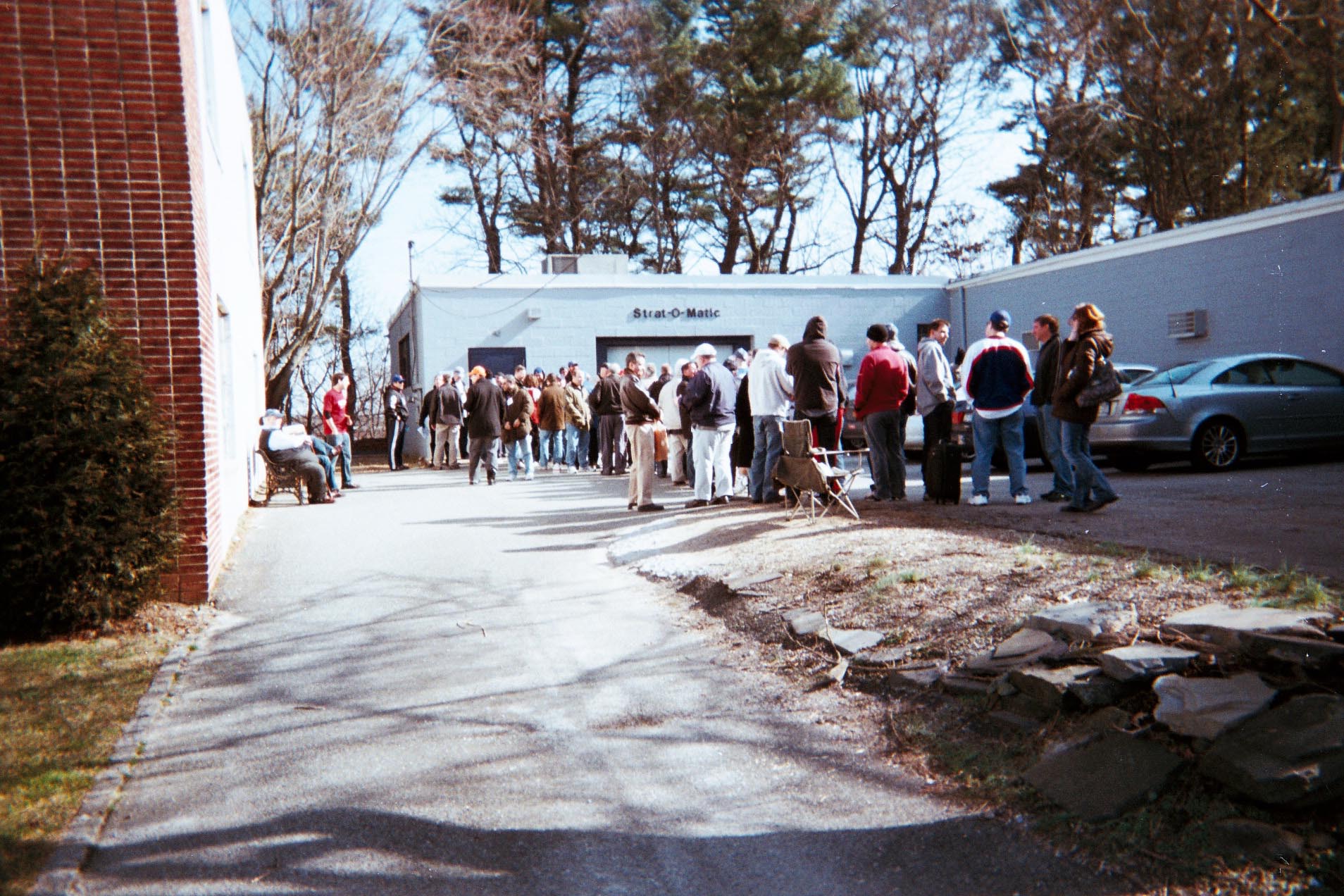
 It’s a brisk but unusually mild early February morning—perfect weather for shagging flies. And even though Major League Baseball’s 2012 season is about a month and a half away, Strat-O-Matic’s 37th Opening Day is in full swing at the company’s home office in Glen Head.
It’s a brisk but unusually mild early February morning—perfect weather for shagging flies. And even though Major League Baseball’s 2012 season is about a month and a half away, Strat-O-Matic’s 37th Opening Day is in full swing at the company’s home office in Glen Head.
The sun is shining down on a queue of around 80 people patiently waiting outside the non-descript two-story gray brick building that sits across from the Glen Head Long Island Rail Road station. Predominantly male and middle-aged, many of these Strat players are local—although there are a number of die-hards who’ve trekked from across the country to wait on this line. And they’re all eager to get their collective hands on the new game sets getting readied for sale to the public at the stroke of noon.
What is Strat-O-Matic? Created in 1961 by Great Neck native Hal Richman, Strat (as it’s known to fans), is best described as Dungeons & Dragons for the fantasy sports set. Two regular six-sided dice and one 20-sided red die are used in conjunction with player cards, offering various hitting and fielding outcomes based on actual statistics from the prior season and thoroughly determined player ratings. And that’s just the basic game—there are also Advanced and Super Advanced versions, where mitigating factors like pitcher fatigue, ballpark dimensions, weather and matchups can be factored into a game’s outcome.
There’s no need, of course, to line up on Opening Day to pick up the new Strat game sets—they can be purchased at any time online. But every year, people are here, on Long Island in February, waiting. This year, the devotees are made up of an interesting array of hardball enthusiasts. Philadelphia native Bryan Killen, for instance, has been playing Strat for 20 years, and is attending his 15th Opening Day.
“This all stems from my love of baseball,” says Killen, sporting a battered Phillies cap and a wide grin. “Strat brings us together, and who has the time to otherwise get together?”
Gene Abood, meanwhile, drove over from Pinebrook, New Jersey, in order to stake his place on line at 7 a.m. An aficionado since getting introduced to the game by his two older brothers in 1972, Abood is still recovering from losing his league’s championship series.
“I just got back from playing our World Tournament in Las Vegas where I lost the World Series,” he says. “I wound up having to eat the card of Tyler Clippard, my game-losing pitcher, after I rolled a 4-9 and he blew the game for me.”
Strat-O-Matic’s origins date back to when 11-year-old sports fan Richman decided to create his own baseball game after becoming dissatisfied with what was then available.
“I had played a game called All Star Baseball and it only measured hitting,” recalls Richman today. “Once you started playing it as often as I did, the spinner used in the game wore down and threw off the averages tremendously. So I took dice in hand and rolled them 5,000 times; I created a probability table and from there started creating the game.”
This nascent version of Strat eventually evolved to include player stats. When Richman was ready to graduate college, he sought to turn this childhood dalliance into a career. He made overtures for seed money to a variety of sources including board game titans Parker Brothers and the Brooklyn Dodgers. These investors took a pass, so it took a $5,000 loan from his father—with the agreement that if Richman were unable to pay back the money in a year’s time, he’d abandon his dreams and come to work at his father’s company.
“The last thing I wanted to do was go into my father’s insurance company,” he recalls. “I borrowed the money with the hopes of being able to pay him back within the year, and fortunately, I was able to.”
In the five decades since Strat-O-Matic hit the market, the game has not only inspired a generation of baseball fans, but expanded to include football, hockey and basketball. Moreover, the game served as a childhood introduction to the inner workings of baseball for a fraternity of analysts, executives and players, including Bob Costas, Theo Epstein and Keith Hernandez, among many others. In an interview with NPR, The Numbers Game author Alan Schwarz declared that a 2002 poll he took of 50 baseball executives found that “exactly half had learned the game in large part by playing Strat-O-Matic as kids.”
And while fantasy baseball is considerably more popular today than Strat, its origins can be traced to Hal Richman’s invention.
“[Rotisserie Baseball inventor] Daniel Okrent was a major Strat-O-Matic player living in New York City,” explains Richman. “When he moved out to a small Massachusetts community to write a book, there were no Strat-O-Matic players in town. In order to keep his fingers on baseball, he developed the fantasy baseball game, or rotisserie, which is what it was then called. In a sense, you could say Strat-O-Matic played a part in creating fantasy baseball.”
ESPN’s Bill Daughtry—a longtime Opening Day fixture—sees the correlation, but feels Strat is the superior product.
“I’ve never done a survey on this but just in casual conversation, you’ll find that people don’t do both,” says Daughtry. “They’ll either do one or the other, and usually one side will frown on the other a little bit. Strat-O-Matic is a more consuming product. You can get into it for the ability to put together a team. Or you can get into it for the ability to manage a team in terms of being in the dugout. You can be the guy who puts the team together. You can be the guy in the front office. You can be the guy who does the statistical analysis…. In fantasy? It’s not the same.”
Back on the line is Kevin Thomas, wearing a Cubs Hat, University of Illinois jacket and New York Rangers jersey with a portable suitcase parked in front of him. Thomas got up at 3:15 that morning at his Wheaton, Ill. home in order to catch a crack-of-dawn flight out of O’Hare International Airport. This is his ninth Opening Day.
“I’m here to pick up cards for my league,” says Thomas. “When I first did this, I wanted to have the experience of doing it, and promised myself that I would only do it one time. At this point my league members have come to depend on my flying out here every year. And while the cards are released on Friday, sets don’t go out in the mail until the following Monday, at which point you don’t know when they’re going to arrive. We need a couple of weeks to pore over the stats, absorb everything and start strategizing for our draft.”
According to Richman, the Opening Day crowd is usually between 150 to 200 people, on average. Richman admits that this devotion never ceases to amaze him.
“One year we had a blizzard—it was snowing and the temperature was around 20 degrees,” recalls Richman. “And we still had 75 people show up. We’ve had people come from as far away as California to personally pick up their sets. I met some fellows today, one of them drove up from Alabama, stopped off to pick a friend up in Tennessee and hit Harrisburg to grab another league member before heading straight here. These friendships started out as work relationships and evolved into something more personal because of their participation in a Strat league.”






